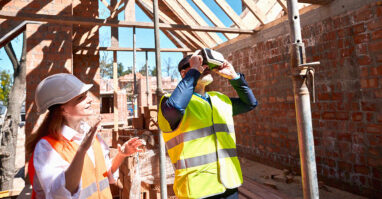Even as the largest industry in the world, construction has not always been at the forefront of innovation and technology. In fact, the industry has been one of the slowest growing despite representing 13% of the global GDP. However, several key construction trends have emerged in recent years that are revolutionizing the way projects are conceived, executed, and managed.
Here is a closer look at how three game-changing advances in design, assembly, and safety have all contributed to booming changes promising to reshape the future of construction in 2024 and beyond.
Virtual Reality
Virtual reality (VR) has become a powerful tool for architects, engineers, and contractors to bring technology into the design and construction process. Notably, VR and virtual design tools enable builders to visualize projects in immersive 3D environments, resulting in better spatial understanding and planning of structures in their physical environment. With reworks and faulty builds accounting for nearly 30% of construction costs, this will prove monumental in helping builders identify and remedy mistakes before ever stepping foot on the construction site.
Tools like Building Information Modeling (BIM) allow architects to explore different design options and configurations in real time, while contractors can identify potential conflicts and streamline construction workflows. VR also facilitates collaboration among project teams, enabling all members to communicate and coordinate more effectively, regardless of their physical location. As VR technology continues to mature and become more accessible, its integration into the construction industry is expected to proliferate across the entire project lifecycle.
Prefab/Modular Homes
Prefabricated (prefab) and modular construction methods have gained significant traction in recent years, offering a faster and vastly more efficient alternative to traditional building techniques. By fabricating roughly 60-90% of building components off-site in controlled factory conditions, prefab homes and other structures can be produced with the speed and efficiency of an assembly line. In addition to keeping costs lower, prefab offers reduced waste, enhanced quality control, and greater design flexibility and customization.
As demand for more sustainable and affordable housing continues to rise, prefab and modular homes are playing a pivotal role in addressing housing shortages with the building of eco-friendly, efficient, and cost-effective multifamily structures in urban environments. It’s also expected that healthcare facilities and hotels are set to largely benefit from the ease and affordability of prefab construction.
Protective Gear and Safety
In addition to advances in construction methods and technology, 2024 has seen a growing emphasis on enhancing safety equipment and practices to protect workers from job-related hazards and accidents. Although construction only represents 5% of the US workforce, it sees the second most workplace deaths and accounts for roughly 18% of all workplace deaths in the US. Therefore, innovative safety equipment, such as wearable sensors, drones, and augmented reality (AR) goggles, are all instrumental in reducing worker injuries and deaths.
Wearable sensors can track workers’ vital signs and detect potential health risks, while drones can perform aerial inspections and survey inaccessible areas more safely and efficiently. AR goggles can overlay digital information onto the physical environment, providing workers real-time guidance and warnings to prevent accidents and injuries. Impact-reducing helmets are another way workers are protecting themselves against falls and construction site hazards.
As the industry continues to evolve to meet the demands of a rapidly changing world, these construction trends are expected to become more readily available and widespread in the coming years. By embracing these advances in technology, construction companies can create safer, more productive work environments, ultimately reducing costs and improving project outcomes.
Want to learn more about how these new technologies can revolutionize your construction business? Please contact our construction team

David Jean is the Practice Leader of the Construction & Real Estate, Business Advisory, and Succession Planning Services Teams. He focuses primarily on financial accounting and consulting for construction, real estate, and manufacturing companies. He is a Certified Construction Industry Financial Professional (CCIFP) and board member and past chairman of the Associated Builders and Contractors of Maine.





